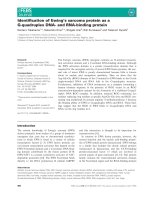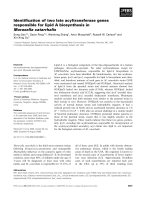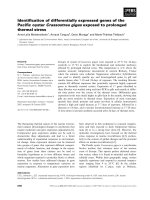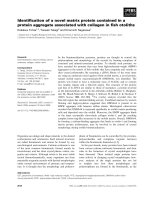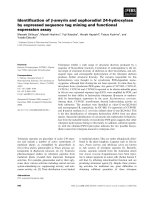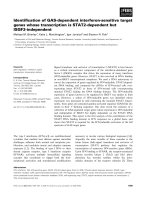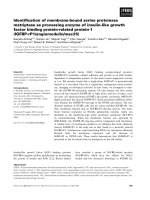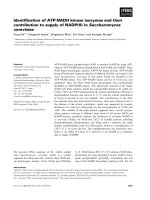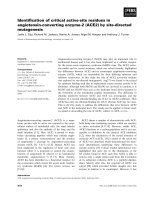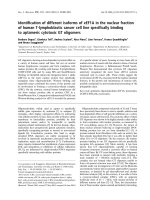Báo cáo khoa học: Identification of an antibacterial protein as L-amino acid oxidase in the skin mucus of rockfish Sebastes schlegeli pot
Bạn đang xem bản rút gọn của tài liệu. Xem và tải ngay bản đầy đủ của tài liệu tại đây (1.45 MB, 12 trang )
Identification of an antibacterial protein as L-amino acid
oxidase in the skin mucus of rockfish Sebastes schlegeli
Yoichiro Kitani
1
, Chihiro Tsukamoto
1
, GuoHua Zhang
1
, Hiroshi Nagai
2
, Masami Ishida
2
,
Shoichiro Ishizaki
1
, Kuniyoshi Shimakura
1
, Kazuo Shiomi
1
and Yuji Nagashima
1
1 Department of Food Science and Technology, Tokyo University of Marine Science and Technology, Japan
2 Department of Ocean Science, Tokyo University of Marine Science and Technology, Japan
Fish have humoral factors elaborated in a nonspecific
defense system against infectious agents [1–3]. The
mucus layer covering the surface of fish has a mechan-
ical protective function and also contains a variety of
biologically active substances, such as complements,
immunoglobulins, lectins, protease inhibitors and lytic
enzymes including lysozyme, that may act as defense
substances [4–6]. Antimicrobial agents are thought to
play an especially important role in the innate immu-
nity of fish, as fish are in intimate contact with the
aquatic environment, which is rich in pathogenic viru-
lence. Indeed, the skin and skin mucus of fish have
been shown to contain antibacterial peptides, including
pardaxin (a 33-residue peptide of Moses sole fish
Pardachirus marmoratus) [7], pleurocidin (a 25-residue
peptide of winter flounder Pleuronectes americanus)
[8,9], grammistins (12–28-residue peptides of soapfishes
Grammistes sexlineatus and Pogonoperca punctata)
[10,11] and moronecidin (a 22-residue peptide of
hybrid striped bass Morone chrysops · Morone saxatri-
lis) [12]. Although the antibacterial peptides described
above are highly heterogeneous with respect to their
Keywords
antibacterial protein; innate immunity;
L-amino acid oxidase; rockfish
Sebastes schlegeli; skin mucus
Correspondence
Y. Nagashima, Department of Food Science
and Technology, Tokyo University of Marine
Science and Technology, Konan 4-5-7,
Minato, Tokyo 108-8477, Japan
Fax: +81 35463 0614
Tel: +81 35463 0604
E-mail:
(Received 30 August 2006, revised 19
October, accepted 6 November 2006)
doi:10.1111/j.1742-4658.2006.05570.x
Fish skin mucus contains a variety of antimicrobial proteins and peptides
that seem to play a role in self defense. We previously reported an antibac-
terial protein in the skin secretion of the rockfish, Sebastes schlegeli, which
showed selective antibacterial activity against Gram-negative bacteria. This
study aimed to isolate and structurally and functionally characterize this
protein. The antibacterial protein, termed SSAP (S. schlegeli antibacterial
protein), was purified to homogeneity by lectin affinity column chromato-
graphy, anion-exchange HPLC and hydroxyapatite HPLC. It was found to
be a glycoprotein containing N-linked glycochains and FAD. Its molecular
mass was estimated to be 120 kDa by gel filtration HPLC and 53 kDa by
SDS ⁄ PAGE, suggesting that it is a homodimer. On the basis of the partial
amino-acid sequence determined, a full-length cDNA of 2037 bp including
an ORF of 1662 bp that encodes 554 amino-acid residues was cloned by
3¢ RACE, 5¢ RACE and RT-PCR. A blast search showed that a mature
protein (496 residues) is homologous to l-amino acid oxidase (LAO) family
proteins. SSAP was determined to have LAO activity by the H
2
O
2
-genera-
tion assay and substrate specificity for only l-Lys with a K
m
of 0.19 mm.It
showed potent antibacterial activity against fish pathogens such as Aero-
monas hydrophila, Aeromonas salmonicida and Photobacterium damselae
ssp. piscicida. The antibacterial activity was completely lost on the addition
of catalase, confirming that H
2
O
2
is responsible for the growth inhibition.
This study identifies SSAP as a new member of the LAO family and
reveals LAO involvement in the innate immunity of fish skin.
Abbreviations
AIP, apoptosis-inducing protein; ConA, concanavalin A; LAO,
L-amino acid oxidase; MIC, minimum inhibitory concentration; SSAP,
Sebastes schlegeli antibacterial protein.
FEBS Journal 274 (2007) 125–136 ª 2006 The Authors Journal compilation ª 2006 FEBS 125
primary structure, they are all positively charged, are
mostly amphipathic, and can form a-helical or b-sheet
structures in membrane-like environments, leading to
membrane destabilization and channel formation in
bacterial cells. Recently, the following histones and
derived peptides have also been identified as antimicro-
bial polypeptides in fish skin secretion: histone H2A
and oncorhycin II (histone H1 C-terminal fragment, a
69-residue peptide) from rainbow trout, Oncorhyn-
chus mykiss [13,14], histone H2B from Atlantic cod,
Gadus morhua [15], histone H2B-like protein from
channel catfish, Ictalurus punctatus [16], parasin I (N-
terminus of histone H2A, a 19-residue peptide) from
catfish, Parasilurus asotus [17], hipposin (histone H2A
fragment, a 51-residue peptide) from Atlantic halibut,
Hippoglossus hippoglossus [18] and SAMP H1 (N-ter-
minus of histone H1, a 30-residue peptide) from Atlan-
tic salmon, Salmo salar [19]. In addition, other kinds
of antibacterial peptides derived from ribosomal and
chromosomal proteins have been detected in the skin
secretions of rainbow trout, O. mykiss and Atlantic
cod, G. morhua [15,20,21]. The antibacterial peptides
from cytosolic or nuclear proteins appear to kill a wide
range of Gram-positive and Gram-negative bacteria,
although their mode of action is not fully understood.
We have found a potent antibacterial protein with
strict selectivity against Gram-negative bacteria from
the skin secretion of rockfish, Sebastes schlegeli [22].
It is of particular interest that this protein is selective
against water-borne pathogenic bacteria such as
Aeromonas hydrophila, Aeromonas salmonicida, Photo-
bacterium damselae ssp. piscicida and Vibrio parahae-
molyticus but not against enteric bacteria such as
Escherichia coli and Salmonella typhimurium, suggest-
ing the importance of the antibacterial protein as a
primary innate immune strategy in the rockfish skin.
In a previous study [22], we obtained the antibacterial
protein by lectin affinity column chromatography and
gel filtration HPLC and reported it to be a glycopro-
tein with a molecular mass of 150 kDa. However, dur-
ing subsequent purification, the antibacterial activity
was found only in the later part of the symmetrical
peak obtained by gel filtration HPLC. Also, the con-
tent of the antibacterial protein in the symmetrical
peak was found to be very low compared with that of
the 150-kDa protein, leading to our previous misidenti-
fication of the 150-kDa protein as an antibacterial pro-
tein. Therefore, the antibacterial protein was again
purified by a revised method to clarify its structure
and functional features in detail. We report here that
the antibacterial protein purified from the skin mucus
of S. schlegeli (SSAP) is a 120-kDa glycoprotein, being
a new member of the l-amino acid oxidase (LAO)
family, and that its antibacterial action is elicited by
H
2
O
2
generated from l-Lys as substrate.
Results
Purification and physicochemical properties of
SSAP
SSAP was purified by three steps of column chroma-
tography. It was retained on the concanavalin A
(ConA)–Sepharose column and recovered in the manno-
pyranoside eluate fraction as reported previously [22]
0
0.1
0.2
0.3
0.4
0.5
0
20
40
60
80
100
120
0 1020304050607080
)UA( ytivitca lairetcabitnA
M)( lCaN fo noitartnecnoC
Retention time (min)
0 1020304050607080
0
0.1
0.2
0.3
0.4
0
5
10
15
20
)
U
A(
y
tivi
t
ca lairetca
b
itnA
M)
(
et
ah
p
s
o
hp
f
o
n
oi
tartn
e
c
noC
Retention time (min)
A
B
40
10
20
30
0
)Um( mn 082
ta ecnabrosbA
)Um( mn 082 ta ecnabrosbA
400
100
200
300
0
500
Fig. 1. Purification of antibacterial protein, SSAP, by Mono Q HR
5 ⁄ 5 anion-exchange HPLC (A) and CHT5-I hydroxyapatite HPLC (B).
(A) Antibacterial fractions obtained by ConA–Sepharose column
chromatography were applied to a Mono Q HR 5 ⁄ 5 column, which
was developed with 0.01
M Tris ⁄ HCl buffer (pH 7.4) for 10 min and
then with a linear gradient of NaCl (0–0.5
M in 60 min) in 0.01 M
Tris ⁄ HCl buffer (pH 7.4) at a flow rate of 0.5 mLÆmin
)1
. (B) The
active fraction from a Mono Q HR 5 ⁄ 5 column was applied to a
CHT5-I column, which was developed with 0.01
M phosphate buf-
fer (pH 6.8) for 10 min and then with a linear gradient method to
0.4
M phosphate buffer (pH 6.8) in 60 min at a flow rate of 0.5 mLÆ
min
)1
. The eluate was monitored by recording A
280
, collected every
minute and used to measure antibacterial activity.
Antibacterial LAO of rockfish skin mucus Y. Kitani et al.
126 FEBS Journal 274 (2007) 125–136 ª 2006 The Authors Journal compilation ª 2006 FEBS
(data not shown). In anion-exchange HPLC on a
Mono Q HR5 ⁄ 5 column, SSAP was eluted between
retention times of 47 and 52 min (Fig. 1A). Finally, it
was purified by HPLC using a CHT5-I hydroxyapatite
column, in which it appeared between retention times
of 47 and 49 min (Fig. 1B). Purified SSAP afforded a
single peak at a retention time of 17.0 min as analyzed
by gel filtration HPLC on a TSKgel G3000SW column
(Fig. 2A). In RP-HPLC, it gave a major peak at a
retention time of 47.3 min along with a minor one at
23.1 min (Fig. 2B). The absorbance spectrum, in which
the major peak exhibited absorption maxima at 213
and 279 nm and the minor peak at 223, 267, 371 and
447 nm (data not shown), suggested the major peak to
be a proteinaceous component, and the minor peak a
flavin-like chromophore. In native and SDS ⁄ PAGE,
purified SSAP afforded only one band (Fig. 3A,B).
These results demonstrate that the purified SSAP was
homogeneous. As summarized in Table 1, 1.7 mg
SSAP was obtained from 150 mL crude skin mucus
extract containing 3890 mg protein. The recovery of
antibacterial activity was 28%, and 645-fold purifica-
tion was achieved on the basis of the minimum inhibi-
tory concentration (MIC).
Judging from the chromatography results, SSAP is
likely to be an acidic glycoprotein with a molecular
1234
0
30
60
90
Retention time (min)
0 20406080
0102030
Retention time (min)
A
B
200
300
0
100
100
0
50
Absorbance at 280 nm (mU)
Absorbance at 220 nm (mU)
Concentration of acetonitrile (%)
Fig. 2. HPLC of antibacterial protein, SSAP,
on a TSKgel G3000SW column (A) and a
Chromolith Performance RP-18e column (B).
(A) SSAP was subjected to gel filtration
HPLC on a TSKgel G3000SW column, elut-
ed with 0.5
M NaCl ⁄ 0.01 M Tris ⁄ HCl buffer
(pH 8.0) at a flow rate of 0.5 mLÆmin
)1
and
monitored by recording A
280
. The following
proteins were used as a reference; 1, ferr-
itin (440 kDa); 2, aldolase (158 kDa); 3, albu-
min (67 kDa); 4, ovalbumin (43 kDa). (B)
SSAP was subjected to RP-HPLC on a
Chromolith Performance RP-18e column,
eluted with a linear gradient of acetonitrile
(0–90% in 60 min) in 0.1% trifluoroacetic
acid at a flow rate of 1.0 mLÆmin
)1
and
monitored by recording A
220
.
AB
Fig. 3. SSAP on native PAGE (A) and SDS/PAGE (B) (A) SSAP was
subjected to native PAGE using a PhastGel homogeneous 20. (B)
SSAP was denatured by heating in 0.01
M Tris ⁄ HCl buffer (pH 6.8)
containing 1% SDS and 6% 2-mercaptoethanol and subjected to
SDS ⁄ PAGE using a PhastGel gradient 8–25. After development,
SSAP was detected using a PhastGel protein silver staining kit.
Table 1. Purification of SSAP. MIC is defined as the lowest con-
centration that inhibited the growth of P. damselae ssp. piscicida
ATCC 51736.
Step
Protein
(mg)
MIC
(lgÆmL
)1
)
Total activity
(protein ⁄ MIC)
Yield
(%)
Crude extract 3890 20 195 000 100
ConA–Sepharose 343 2.7 127 000 65
Mono Q HR 5 ⁄ 5 16.1 0.22 73 200 38
CHT5-I 1.7 0.031 54 800 28
Y. Kitani et al. Antibacterial LAO of rockfish skin mucus
FEBS Journal 274 (2007) 125–136 ª 2006 The Authors Journal compilation ª 2006 FEBS 127
mass of 120 kDa. SDS ⁄ PAGE analysis revealed a
molecular mass of 53 kDa (Fig. 3B), suggesting that
SSAP has a dimeric conformation. It was found to
contain 1.6% (w ⁄ w) of d-mannose and 0.6% (w ⁄ w) of
N-acetyl-d-glucosamine by HPLC after derivatization
with 4-aminobenzoic acid ethyl ester. A sugar moiety
was effectively liberated by digestion of SSAP with gly-
copeptidase F. As seen in Fig. 4, the digest migrated
ahead of the intact SSAP and gave no detectable band
when the ECL glycoprotein detection module was
used, indicating the presence of an N-linked carbohy-
drate side chain in SSAP.
Purified SSAP was yellow-colored, suggesting the
involvement of flavin in the molecule, as supported by
the RP-HPLC result. As illustrated in Fig. 5A, the
chromophore dissociated from SSAP on heating with
SDS showed absorption maxima at 263, 371 and
447 nm, consistent with those of the FAD standard.
Figure 5B shows the mass spectrum of the chromo-
phore from SSAP. ESI-TOF-MS in the positive mode
gave the main peak at m ⁄ z 786.32 and the ion peaks at
m ⁄ z 439.60 and 348.63. The former corresponded to
the parent ion peak of [M +H]
+
of FAD (molecular
mass 785.56 Da), and the latter ion peaks at m ⁄ z
439.60 and 348.63 were assignable to fragment A
(a dehydro ion of adenosine monophosphate, C
10
H
13
N
5
O
7
P) and fragment B (a dehydroxy ion of flavin
mononucleotide, C
17
H
20
N
4
O
8
P), respectively, accord-
ing to a rule of mass shift in fragmentation [23]. These
results provide evidence that FAD is the chromophore
of SSAP.
The CD spectrum of SSAP is shown in Fig. 6. SSAP
clearly gave two negative peaks at 208 and 222 nm in
0.5 m NaCl ⁄ 0.01 m Tris ⁄ HCl buffer (pH 8.0), indicating
B
50
37
150
100
75
12
12M
(kDa)
A
Fig. 4. SSAP on SDS ⁄ PAGE (A) and poly(vinylidene difluoride)
membrane (B) before and after treatment with glycopeptidase F.
(A) Protein was detected using a PhastGel protein silver staining
kit. (B) Glycoprotein was visualized using an ECL glycoprotein
detection module. Lane M, molecular mass marker; lane 1, SSAP;
lane 2, SSAP treated with glycopeptidase F.
B
A
250 300 350 400 450 500
ecnabrosbA
Wave length (nm)
FAD standard
Chromophore from SSAP
A
B
FAD standard
348.62
439.60
786.30
100
100
348.63
439.60
786.32
100 200 300 400 500 600 700 800 900
m/z
100 200 300 400 500 600 700 800 900
m/z
Chromophore from SSAP
)%( ytisnetnI
)%( ytisnetnI
0
0
Fig. 5. Absorption spectra (A) and mass spectra (B) of FAD stand-
ard and the chromophore derived from SSAP. The chromophore
was obtained by boiling SSAP in 1% SDS for 10 min, ultrafiltration
using an Ultrafree-MC, and RP-HPLC on a Chromolith Performance
RP-18e column with a linear gradient of acetonitrile (5–25% in
10 min) in 0.1% trifluoroacetic acid at a flow rate of 1.0 mLÆmin
)1
.
FAD standard was obtained by application of FAD sodium salt
hydrate to RP-HPLC under the same conditions as the chromo-
phore. The inset in (B) illustrates the structure of FAD.
Antibacterial LAO of rockfish skin mucus Y. Kitani et al.
128 FEBS Journal 274 (2007) 125–136 ª 2006 The Authors Journal compilation ª 2006 FEBS
a-helical conformation. The a-helical content of SSAP
in the buffer was found to be 20% and increased to 28%
on the addition of SDS irrespective of concentration in
the range 0.1–2.5%.
cDNA cloning and sequence analysis of SSAP
The N-terminal amino-acid sequence of SSAP was
determined to be ISLRDNLAD. Of the peptide frag-
ments isolated from the lysyl endopeptidase digest by
RP-HPLC, three (fragments 1–3) were randomly selec-
ted and sequenced as follows: SADELLQHALQK for
fragment 1, EGWYAELGAMRIPS for fragment 2, and
SYTWSDDSLLFLGASDED for fragment 3. A cDNA
fragment was successfully amplified by 3¢ RACE using
the degenerate primers designed from the amino-acid
sequence of fragment 1. On the basis of the nucleotide
sequence of this cDNA fragment, the remaining 5¢
region sequence was determined by 5¢ RACE. Thus, the
nucleotide sequence of the full-length SSAP cDNA
(2037 bp) was elucidated (DDBJ accession number
AB218876). The accuracy of this sequence was verified
by recloning experiments. The 5¢-untranslated region
contains stop codons TAA and TGA at nucleotides 4–6
and 31–33, respectively, upstream of the initial codon
ATG present at nucleotides 46–48. In the 3¢-untrans-
lated region, a polyadenylation signal AATAAA is
observed at nucleotides 1997–2002, and a poly(A) tail
at nucleotide 2027. An ORF is composed of 1662 bp,
encoding a precursor protein of 554 amino-acid residues
from the putative initiating Met to the putative last Leu.
The amino-acid sequences of the N-terminal portion
and the lysyl endopeptidase fragments 1–3 determined
by protein sequencing are all found at positions 59–67
(N-terminal portion), 138–151 (fragment 2), 210–221
(fragment 1) and 436–453 (fragment 3) of the deduced
molecule (Fig. 7).
signalp version 3.0 ( />SignalP/) predicted that SSAP consists of a signal pep-
tide (Met1–Ala58) and a mature protein starting with
Ile59, in accord with the result of N-terminal protein
sequence analysis. It is likely that the mature protein is
composed of 496 amino acids with a calculated
molecular mass of 55 260.63 Da. A blast homology
search showed the similarity of the deduced amino-
acid sequence of SSAP to LAOs. Amino-acid sequence
alignment analysis using clustalw (version 1.83)
revealed that SSAP shows a weak homology to anti-
bacterial LAOs, such as aplysianin A (11%), achacin
(12%) and escapin (12%), and a moderate homology
to Pseudechis australis snake venom LAO (42%). The
highest identity (76%) was observed with the apopto-
sis-inducing protein (AIP) derived from the viscera of
mackerel infected with the nematode, Anisakis simplex
[24] (Fig. 7).
LAO activity of SSAP
SSAP exhibited high LAO activity, with a specific
activity of 10.2 UÆmg
)1
by the H
2
O
2
-generation
method. SSAP catalyzed oxidation of only l-Lys and
was ineffective with any of the other proteinaceous
amino acids tested. No LAO activity was detected
when l-Lys was replaced with d-Lys (Fig. 8). From a
Lineweaver–Burk plot of LAO activity of SSAP (data
not shown), K
m
and k
cat
were evaluated to be 0.19 mm
and 20.4 s
)1
, respectively.
Antibacterial action of SSAP
As shown in Table 2, SSAP specifically inhibited the
growth of Gram-negative bacteria, being most active
against A. salmonicida with an MIC of 0.078
lgÆmL
)1
, followed by P. damselae ssp. piscicida,
A. hydrophila and V. parahaemolyticus with MIC of
0.16, 0.31 and 0.63 lgÆmL
)1
, respectively. LAOs have
been reported to show antibacterial activity through
H
2
O
2
generated from amino-acid substrates, which is
markedly diminished in the presence of H
2
O
2
scaven-
gers such as catalase and peroxidase [25–27]. In
the present study therefore the inhibitory effect of
Fig. 6. CD spectra of SSAP. CD analyses were performed using a
quartz optical cell with 10-mm path length at 25 °C. Each spectrum
represents the mean of three measurements in the range 200–
250 nm at 0.5-nm intervals. Solvent: (m) 0.5
M NaCl ⁄ 0.01 M
Tris ⁄ HCl buffer (pH 8.0) and (n) 0.1% SDS, (s) 0.5% SDS and (d)
2.5% SDS in 0.5
M NaCl ⁄ 0.01 M Tris ⁄ HCl buffer (pH 8.0).
Y. Kitani et al. Antibacterial LAO of rockfish skin mucus
FEBS Journal 274 (2007) 125–136 ª 2006 The Authors Journal compilation ª 2006 FEBS 129
catalase on the antibacterial activity of SSAP was
examined. The addition of catalase almost completely
abolished the antibacterial activity of SSAP, indica-
ting that H
2
O
2
is the mediator of the activity of
SSAP.
Discussion
This study is the first to discover an LAO with anti-
bacterial activity in the skin mucus of a teleost and to
reveal the involvement of LAO in the innate immunity
Fig. 7. Amino-acid sequence alignment of SSAP (DDBJ accession number AB218876) with AIP from mackerel Scomber japonicus (DDBJ
accession number AJ400871), PA-LAO from Pseudechis australis snake venom (DDBJ accession number DQ088992), aplysianin A from
Aplysia kurodai (DDBJ accession number D83255), escapin from Aplysia californica (DDBJ accession number AY615888) and achacin from
Acatina fulica (DDBJ accession number X64584). Identical amino acids are shaded. Potential N-glycosylation sites are boxed. Gaps intro-
duced into the sequences to optimize the alignment are represented by dashes. The N-terminal sequence (59–67) and intrapeptide frag-
ments 1 (210–221), 2 (138–151) and 3 (436–453) of SSAP are thick underlined.
Antibacterial LAO of rockfish skin mucus Y. Kitani et al.
130 FEBS Journal 274 (2007) 125–136 ª 2006 The Authors Journal compilation ª 2006 FEBS
of fish skin. In a previous report [22], the antibacterial
protein was obtained from the skin secretion of rock-
fish S. schlegeli by lectin affinity chromatography and
gel filtration HPLC and misidentified as a 150-kDa
glycoprotein consisting of 75-kDa subunits by SDS ⁄
PAGE, partly because of the scarcity of the protein of
interest. In this study therefore we isolated the antibac-
terial protein, SSAP, from the skin mucus of S. schle-
geli by a combination of three different types of
column chromatography and carefully examined the
degree of purity by HPLC as well as PAGE. Further-
more, we elucidated the primary structure of SSAP by
cDNA cloning and identified SSAP to be a new mem-
ber of the LAO family by physicochemical and bio-
chemical analyses. LAOs (EC 1.4.3.2) catalyze the
stereospecific oxidative deamination of an l-amino-
acid substrate to a corresponding a-oxoacid with the
production of H
2
O
2
and ammonia, via an imino-acid
intermediate. It is well known that these enzymes are
widely distributed across diverse phyla from bacteria
to mammals. LAOs in micro-organisms appear to be
involved in the utilization of ammonia as a nitrogen
source, and those in animals have been characterized
as showing distinct biological and physiological effects
such as apoptosis, cytotoxicity, hemolysis, platelet
aggregation, hemorrhage, edema and antimicrobial
activity [28]. Since Skarnes [29] first found antibacterial
activity in an LAO from snake (Crotalus adamanteus)
venom, antibacterial LAOs have been reported from
snake venoms of Ps. australis [30], Trimeresurus jerdo-
nii [31] and Bothrops alternatus [32], the body surface
mucus of the giant African snail, Achatina fulica
Fe
´
russac (termed achacin) [26], the albumen gland of
the sea hare, Aplysia kurodai (termed aplysianin A)
[27], and the ink of the sea hare, A. californica (termed
escapin) [33].
LAO family members possess in common flavin as a
coenzyme and two motifs, a dinucleotide-binding motif
comprising b-strand ⁄ a-helix ⁄ b-strand of the secondary
structure, and a GG motif (R-x-G-G-R-x-x-T ⁄ S)
shortly after the dinucleotide-binding motif [34]. In the
case of SSAP, FAD was identified as a coenzyme.
Moreover, the dinucleotide-binding motif to which
FAD binds was certainly recognized at amino-acid resi-
dues His93–Glu121, and the GG motif at amino-acid
residues Arg125–Thr132 (Fig. 7). A blast search found
that SSAP shares the highest sequence identity (76%)
with AIP from Anisakis-infected mackerel. The secon-
dary structures of SSAP and AIP appear to be similar
to each other. The a-helix content of SSAP was deter-
mined to be 28.2% in 2.5% SDS solution by CD
spectrometry and calculated to be 31.6% by predator
( />simple.html), and that of AIP was estimated to be
26.9% by predator. In addition, both SSAP and AIP
have strict specificity with respect to the substrate, cata-
lyzing the oxidation of only l-Lys. These results suggest
structural similarity between their substrate-binding
sites.
SSAP and AIP have two and five potential N-glyco-
sylation sites, respectively. One site at residues 89–91 is
common to both LAOs. SSAP was determined to con-
tain 2 mol d-mannose and 5 mol N-acetyl-d-glucosa-
mine per mol of subunit. Treatment of SSAP with
glycopeptidase F resulted in deglycosylation (Fig. 4),
but did not reduce antibacterial activity, suggesting
no or little involvement of the sugar moiety in the
antibacterial effect of SSAP. It has been reported that
Fig. 8. Dependence of substrate concentration on LAO activity of
SSAP. LAO activity was measured by the H
2
O
2
-generation assay.
Reaction rate is defined as generation of H
2
O
2
per min. d, L-Lys;
s,
D-Lys.
Table 2. Antibacterial spectrum of SSAP. MIC is defined as the
lowest concentration that inhibited the growth of bacteria.
Bacterium
MIC (lgÆmL
)1
)
SSAP
SSAP with
catalase
Gram-positive
B. subtilis IAM1026 > 5.0 > 5.0
M. luteus IAM1056 > 5.0 > 5.0
Staph. aureus IAM1011 > 5.0 > 5.0
Gram-negative
A. hydrophila IAM12337 0.31 > 5.0
A. salmonicida JCM7874 0.078 > 5.0
E. coli JCM1649 > 5.0 > 5.0
P. damselae ssp. piscicida ATCC51736 0.16 > 5.0
S. typhimurium SH-1 > 5.0 > 5.0
V. parahaemolyticus NBRC12711 0.63 > 5.0
Y. Kitani et al. Antibacterial LAO of rockfish skin mucus
FEBS Journal 274 (2007) 125–136 ª 2006 The Authors Journal compilation ª 2006 FEBS 131
glycosylation is not essential for the antibacterial activ-
ity of escapin, which has one putative glycosylation
site, as recombinant escapin expressed in bacteria is as
active as the native one [33]. On the other hand, Geyer
et al. [35] examined the structure of the glycan moiety
of the LAO from the Malayan pit viper, Calloselas-
ma rhodostoma, and assumed that putative binding of
the LAO to sialic acid-binding Ig superfamily lectins
via its sialylated glycan moiety results in the produc-
tion of locally high concentrations of H
2
O
2
in or near
the binding interface. The role of the glycosyl substitu-
ents of LAOs in biological activities remains to be
elucidated.
It should be noted that SSAP only has potent antibac-
terial activity against specific Gram-negative bacteria,
including fish pathogens (A. hydrophila, A. salmonicida
and P. damselae ssp. piscicida) and a marine bacterium
(V. parahaemolyticus), but not against enteric Gram-
negative bacteria (E. coli and S. typhimurium). In
contrast, other antibacterial LAOs, such as achacin,
aplysianin A and escapin, broadly show an inhibitory
effect on both Gram-negative (E. coli ) and Gram-posit-
ive bacteria (Bacillus subtilis and Staphylococcus aure-
us). The antibacterial activities of these LAOs, including
SSAP, are significantly decreased in the presence of cat-
alase, confirming that H
2
O
2
generation by LAOs brings
about an oxidative burst in cells that is responsible for
cell death. Shur & Kim [36] reported that the LAO from
snake (Agkistrodon halys) venom attaches to the cell
surface of mouse lymphocytic leukemia L1210, inducing
apoptosis in a cell-selective manner. Similarly, achacin
from the giant African snail binds to the cell wall of
E. coli, and its LAO activity is inhibited by N-acetylneu-
raminic acid [26,37]. Therefore, it is possible that the
cell-specific antibacterial activity of SSAP is associated
with its binding to the bacterial cell surface. Further
investigation is in progress to elucidate the bacterium
selectivity and the mode of action of SSAP. Finally,
SSAP is likely to be important in the innate host defense
on the skin of rockfish and might be useful as a chemo-
therapeutic agent, especially in the field of aquaculture
because of its selective cytotoxicity against water-borne
virulent pathogens.
Experimental procedures
Materials
Specimens of S. schlegeli ranging from 28.0 to 32.5 cm in
body length were obtained from Minami-Sanriku Marine
Center, Motoyoshi, Miyagi Prefecture, Japan, and trans-
ported in oxygen-saturated water to our laboratory.
Purification of SSAP
The rockfish skin mucus was gently scraped off with a spat-
ula, combined, and centrifuged at 18 800 g for 30 min using
an angle rotor (SCR18B; Hitachi, Tokyo, Japan). The result-
ing supernatant was applied to a ConA–Sepharose column
(2.0 · 32.0 cm; GE Healthcare Bio-Science, Piscataway, NJ,
USA), which was washed with 1 mm CaCl
2
⁄ 1mm
MnCl
2
⁄ 0.5 m NaCl ⁄ 0.02 m Tris ⁄ HCl buffer (pH 7.4) and
then eluted with 0.5 m methyl-a-d-mannopyranoside ⁄ 0.5 m
NaCl ⁄ 0.02 m Tris ⁄ HCl buffer (pH 7.4) as reported previ-
ously [22]. Antibacterial fractions were pooled and subjected
to HPLC on a Mono Q HR5 ⁄ 5 column (0.5 · 5.0 cm; GE
Healthcare Bio-Science). The column was developed by a
linear gradient of NaCl (0–0.5 m in 60 min) in 0.01 m
Tris ⁄ HCl buffer (pH 7.4) at a flow rate of 0.5 mLÆmin
)1
.
Finally, the antibacterial protein was purified by HPLC on a
CHT5-I hydroxyapatite column (1.0 · 6.4 cm; Bio-Rad
Laboratories, Hercules, CA, USA) with a linear gradient
elution of 0.01–0.4 m phosphate buffer (pH 6.8) in 60 min at
a flow rate of 0.5 mLÆmin
)1
. At each chromatographic step,
proteins were monitored by recording A
280
and the antibac-
terial protein by growth inhibition against P. damselae ssp.
piscicida. The purified antibacterial protein was SSAP.
For purity determination, SSAP was subjected to either
gel filtration HPLC on a TSKgel G3000SW column
(0.78 · 30 cm; Tosoh, Tokyo, Japan) with 0.5 m NaCl ⁄
0.01 m Tris ⁄ HCl buffer (pH 8.0) at a flow rate of 0.5 mLÆ
min
)1
or RP-HPLC on a Chromolith Performance RP-18e
column (0.46 · 10 cm; Merck, Darmstadt, Germany) with a
linear gradient of acetonitrile (0–90% in 60 min) in 0.1%
trifluoroacetic acid at a flow rate of 1.0 mLÆmin
)1
. SSAP
was monitored by recording A
220
or A
280
with a photodiode
array detector. SSAP was analyzed for its homogeneity by
PAGE with a PhastSystem apparatus (GE Healthcare
Bio-Science) according to the manufacturer’s instructions.
Native PAGE was carried out on a PhastGel homogeneous
20 with PhastGel native buffer strips, and SDS ⁄ PAGE on a
PhastGel gradient 8–25 with PhastGel SDS buffer strips.
Before SDS ⁄ PAGE, SSAP was dissolved in 0.01 m Tris ⁄ HCl
buffer (pH 6.8) containing 1% SDS and 6% 2-mercaptoeth-
anol and heated in a boiling-water bath for 5 min. After
being run, the gel was stained with a PhastGel protein silver
staining kit (GE Healthcare Bio-Science).
Analysis of amino-acid sequence
Amino-acid sequence analyses of SSAP and its peptide
fragments produced by digestion with lysyl endopeptidase
(EC 3.4.21.50; Wako Pure Chemical Industries, Osaka,
Japan) were performed with an automatic gas-phase
sequencer (LF-3400D TriCart with high sensitivity chem-
istry; Beckman Coulter, Fullerton, CA, USA). To produce
peptide fragments, SSAP (60 lg) was denatured in 400 lL
Antibacterial LAO of rockfish skin mucus Y. Kitani et al.
132 FEBS Journal 274 (2007) 125–136 ª 2006 The Authors Journal compilation ª 2006 FEBS
4 m urea, diluted twofold with 0.1 m Tris ⁄ HCl buffer
(pH 9.3) and digested with 1 lg lysyl endopeptidase at
37 °C for 24 h. The digest was subjected to RP-HPLC on a
Chromolith Performance RP-18e column (0.46 · 10 cm;
Merck) with a linear gradient of acetonitrile (0–70% in
120 min) in 0.1% trifluoroacetic acid at a flow rate of
0.5 mLÆmin
)1
. Peptides were monitored at 220 nm with a
photodiode array detector.
cDNA cloning
Total RNA was extracted from the skin of a live specimen
with TRIzol reagent (Invitrogen, Carlsbad, CA, USA). First-
strand cDNA was synthesized from 5 lg total RNA using a
3¢ RACE System for Rapid Amplification of cDNA Ends
Kit (Invitrogen) following the manufacturer’s instructions.
Oligonucleotide primers were designed on the basis of the
determined amino-acid sequences of peptide fragments. The
degenerate primer 5¢-CIGAYGARYTIYTICARAYGCIYT
IC-3¢ (forward; corresponding to
211
ADELLQHAL
219
) and
the abridged universal amplification primer (AUAP) 5¢-GG
CCACGCGTCGACTAGTAC-3¢ (reverse) were used for the
first 3¢ RACE, and the degenerate primer 5¢-AYGARYTIY
TICARCAYGCIYTICARAA-3¢ (forward; corresponding to
212
DELLQHALQK
221
) and the AUAP (reverse) for the sec-
ond 3¢ RACE. Amplification was carried out using rTaq
polymerase (Takara, Otsu, Japan) under the following condi-
tions: 94 °C for 5 min; 35 cycles of 94 °C for 30 s, 55 °C for
30 s and 72 °C for 90 s; and 72 °C for 5 min. The secondary
PCR products were subcloned into the pT7Blue T-vector
(Novagen, Darmstadt, Germany), and their nucleotide
sequences were analyzed with a Thermo Sequenase Cy5 Dye
Terminator Sequencing Kit (GE Healthcare Bio-Science)
and a Long-Read Tower DNA Sequencer (GE Healthcare
Bio-Science). The remaining 5¢-terminal sequence was ana-
lyzed by 5¢ RACE as follows. First-strand cDNA was syn-
thesized from 5 l g total RNA using a 5¢ RACE System for
Rapid Amplification of cDNA Ends Kit (Invitrogen) and the
gene-specific primer (5¢-CCTTCTTCTTTCAGATAATCC-
3¢, corresponding to
244
KDYLKEEG
251
). The first 5¢ RACE
reaction was completed using the gene-specific primer (5¢-
AGAGTAACGGTCATATTTTAGC-3¢, corresponding to
235
LLKYDRYS
242
) and the abridged anchor primer (AAP)
5¢-GGCCACGCGTCGACTAGTACGGGIIGGGIIGGGI
IG-3¢, followed by reamplification of the PCR products using
the gene-specific primer (5¢-CCACCTCATCTTGCACCT
TC-3¢, corresponding to
220
QKVQDEVE
227
) and the AUAP.
Amplification conditions were the same as described above.
The secondary PCR products were subcloned into the
pT7Blue T-vector and sequenced. The nucleotide sequence
of the full-length SSAP cDNA was confirmed by RT-PCR
using the forward primer 5¢-ATAACTTTGGAGACGG
AGTTC-3¢ and the reverse primer 5¢-TGGAGGAACATTA
GTGGTCC-3¢.
Measurement of LAO activity
LAO activity was assayed in a 96-well microtiter plate by
the peroxidase ⁄ o-phenylenediamine method [24] with slight
modifications. For the standard assay, 25 lL SSAP, 25 lL
20 mml-Lys, 25 lL peroxidase (0.2 UÆmL
)1
; Type VI;
EC 1.11.1.7; Sigma-Aldrich Corp., St Louis, MO, USA)
and 25 lL o-phenylenediamine (0.5 mgÆmL
)1
) were added
sequentially to the well. After incubation at 37 °C for
150 min, the reaction was terminated by adding 100 lL1m
H
2
SO
4
, and A
490
was measured. The substrate specificity of
SSAP was examined using Gly, 19 l-amino acids and
d-Lys as the substrates. To determine kinetic parameters,
various concentrations (0–5 mm)ofl-Lys were used. K
m
was evaluated using a Lineweaver–Burk plot by measuring
the rate of H
2
O
2
production.
Measurement of antibacterial activity
Antibacterial activity was measured by a liquid growth-inhi-
bition assay in a 96-well microtiter plate, as previously repor-
ted [22]. The following nine species of bacteria were used:
three species of Gram-positive bacteria, B. subtilis IAM1026,
Micrococcus luteus IAM1056 and Staph. aureus IAM1011;
six species of Gram-negative bacteria, A. hydrophila
IAM12337, A. salmonicida JCM7874, E. coli JCM1649,
P. damselae ssp. piscicida ATCC51736, S. typhimurium
SH-1 isolated from fish meal, and V. parahaemolyticus
NBRC12711. During the isolation procedure of the antibac-
terial protein, P. damselae ssp. piscicida was used because of
its high sensitivity to SSAP [22]. Briefly, a mixture of 50 lL
sample solution and 50 lL bacterial suspension (1 · 10
5
col-
ony-forming unitsÆmL
)1
), both of which were made in
Muller-Hinton broth medium (Difco Laboratories, Detroit,
MI, USA), was incubated at 25 °C for 24 h. After incuba-
tion, bacterial growth was observed with the unaided eye.
When the culture medium was completely transparent or no
precipitate was recognized, inhibition of bacteria growth was
judged to have occurred. The reciprocal of the maximum
inhibitory dilution was used to calculate arbitrary units (AU)
per ml. The MIC was defined as the lowest concentration
that inhibited the growth of bacteria. To examine the inhibi-
tory effect of catalase on the antibacterial activity of SSAP,
50 U catalase (EC 1.11.1.6; from bovine liver; Wako Pure
Chemical Industries) was added to the culture medium con-
taining 5 lgÆmL
)1
SSAP and bacterial cells, and the mixture
was incubated under the same condition as described above.
Determination of molecular mass
The molecular mass of the native SSAP was determined
by gel filtration HPLC on a TSKgel G3000SW column
(0.78 · 30 cm; Tosoh) as described above. Four reference
Y. Kitani et al. Antibacterial LAO of rockfish skin mucus
FEBS Journal 274 (2007) 125–136 ª 2006 The Authors Journal compilation ª 2006 FEBS 133
proteins, ferritin (440 kDa), aldolase (158 kDa), albumin
(67 kDa) and ovalbumin (43 kDa), were used to calibrate
the column. The molecular mass of the denatured SSAP
was determined by SDS ⁄ PAGE on a PhastGel gradient
8–25 with PhastGel SDS buffer strips (GE Healthcare
Bio-Science) as described above. Precision Plus Pro-
tein standard (Bio-Rad Laboratories) was used as a refer-
ence.
Analysis of FAD
An aliquot of SSAP (5 lg) was boiled in 200 lL 1% SDS
for 10 min and filtered with an Ultrafree-MC (molecular
mass cut off 10 kDa; Millipore, Bedford, MA, USA). The
filtrate was chromatographed on a Chromolith Performance
RP-18e column (0.46 · 10 cm; Merck) with a linear gradi-
ent of acetonitrile (5–25% in 10 min) in 0.1% trifluoroace-
tic acid at a flow rate of 1.0 mLÆmin
)1
, with monitoring by
recording A
447
. The eluate containing the chromophore was
collected and subjected to spectrophotometry and MS. The
MS ⁄ MS measurement of the chromophore was performed
using a Q-tof Ultimate API (Micromass, Altrincham, UK)
in the positive-ion mode under the following conditions:
capillary voltage, 3200 V; cone voltage, 100 V; desolvation
temperature, 150 °C; source temperature, 80 °C; collision
gas, argon.
CD spectrometry
SSAP (30 lg) was dissolved in 3 mL 0.5 m NaCl ⁄ 0.01 m
Tris ⁄ HCl buffer (pH 8.0) containing 0%, 0.1%, 0.5% or
2.5% SDS and subjected to CD analysis with a CD spec-
tropolarimeter (J-720; Jasco, Tokyo, Japan). The CD spec-
tra were measured at 25 °C with 40 scans per min in the
range 200–250 nm at 0.5-nm intervals. a-Helical contents
were calculated by the method of Greenfield & Fasman
[38].
Carbohydrate analysis
SSAP (2 lg) was deglycosylated by incubation with glyco-
peptidase F (25 · 10
)3
U; EC 3.5.1.52; Sigma-Aldrich Corp.)
in 10 lL 0.05 m Tris ⁄ HCl buffer (pH 8.6) at 37 °C for 18 h
and subjected to SDS ⁄ PAGE. The proteins separated by
SDS ⁄ PAGE were electrotransferred from the gel to a
poly(vinylidene difluoride) membrane and visualized by the
chemical luminescence method using an ECL glycoprotein
detection module (GE Healthcare Bio-Science) following the
manufacturer’s instructions. Total sugar composition analy-
sis was performed using the ABEE (4-aminobenzoic acid
ethyl ester) labeling kit plus S (Seikagaku Corporation,
Tokyo, Japan) and HPLC on a Honenpak C18
(0.46 · 7.5 cm; Seikagaku Corporation), as reported previ-
ously [22].
Determination of protein
Protein was determined by the micro bicinchoninic acid
method [39] using BSA as a standard protein.
Acknowledgements
This study was partly supported by a Grant-in Aid for
Scientific Research from the Ministry of Education,
Science, Sports and Culture of Japan. We thank Dr
Y. Shida, Tokyo College of Pharmacy, for MS analysis
for FAD, and Mr T. Katsukura and Mr H. Oikawa,
Minami-Sanriku Marine Center, for provision of the
rockfish specimens.
References
1 Iwama G & Nakanishi T (1996) The Fish Immune
System. Academic press, San Diego, CA.
2 Bayne CJ & Gerwick L (2001) The acute phase response
and innate immunity of fish. Dev Comp Immunol 25,
725–743.
3 Ellis AE (2001) Innate host defense mechanisms of fish
against viruses and bacteria. Dev Comp Immunol 25,
827–839.
4 Alexander JB & Ingram GA (1992) Noncellular
nonspecific defense mechanism of fish. Annu Rev Fish
Dis 2, 249–279.
5 Kozineko II, Isaeva NM & Balakhnin IA (1999)
Humoral factors of nonspecific defense in fish.
J Ichthyol 39, 322–328.
6 Maganadottir B (2006) Innate immunity of fish
(overview). Fish Shellfish Immunol 20 , 137–151.
7 Oren Z & Shai Y (1996) A class of highly potent
antibacterial peptides derived from pardaxin, a
pore-forming peptide isolated from Moses sole
fish Pardachirus marmoratus. Eur J Biochem 237,
303–310.
8 Cole AM, Weis P & Diamond G (1997) Isolation and
characterization of pleurocidin, an antimicrobial peptide
in the skin secretions of winter flounder. J Biol Chem
272, 12008–12013.
9 Saint N, Cadiou H, Bessin Y & Molle G (2002)
Antibacterial peptide pleurocidin forms ion channel
in planner lipid bilayer. Biochim Biophys Acta 1564,
359–364.
10 Yokota H, Nagashima Y & Shiomi K (2001) Interac-
tion of grammistins with lipids and their antibacterial
activity. Fish Sci 67, 928–933.
11 Sugiyama N, Araki M, Ishida M, Nagashima Y &
Shiomi K (2005) Further isolation and characterization
of grammistins from the skin secretion of the soapfish
Grammistes sexlineatus. Toxicon 45, 595–601.
Antibacterial LAO of rockfish skin mucus Y. Kitani et al.
134 FEBS Journal 274 (2007) 125–136 ª 2006 The Authors Journal compilation ª 2006 FEBS
12 Lauth X, Shike H, Burus JC, Westerman ME, Ostland
VE, Carlberg JM, VanOlst JC, Nizet V, Taylar SW,
Shimizu C, et al. (2002) Discovery and characterization
of two isoforms of moronecidin, a novel antimicrobial
peptides from hybrid striped bass. J Biol Chem 277,
5030–5039.
13 Fernandes JMO, Kemp GD, Molle MG & Smith VJ
(2002) Anti-microbial properties of histone H2A from
skin secretions of rainbow trout, Oncorhynchus mykiss.
Biochem J 368, 611–620.
14 Fernandes JMO, Molle MG, Kemp GD & Smith VJ
(2004) Isolation and characterization of oncorhyncin II,
a histone H1-derived antimicrobial peptide from skin
secretions of rainbow trout, Oncorhynchus mykiss. Dev
Comp Immunol 28, 127–138.
15 Bergsson G, Agerberth B, Jo
¨
rnvall H & Gudmunds-
son GH (2005) Isolation and identification of
antimicrobial components from the epidermal mucus
of Atlantic cod (Gadus morhua). FEBS J 272, 4960–
4969.
16 Robinette D, Wada S, Arroll T, Levy MG, Miller WL
& Noga EJ (1998) Antimicrobial activity in the skin of
the channel catfish Ictalurus punctatus: characterization
of broad-spectrum histone-like antimicrobial proteins.
Cell Mol Life Sci 54, 467–475.
17 Park IY, Park CB, Kim MS & Kim SC (1998) Parasin I,
an antimicrobial peptide derived from histone H2A
in the catfish, Parasilurus asptus. FEBS Lett 437,
258–262.
18 Birkemo GA, Lu
¨
ders T, Andersen Ø, Nes IF &
Nissen-Meyer J (2003) Hipposin, a histone-derived
antimicrobial peptide in Atlantic halibut ( Hippoglossus
hippoglossus L.). Biochim Biophys Acta 1646, 207–
215.
19 Lu
¨
ders T, Birkemo GA, Nissen-Meyer J, Andersen Ø &
Nes IF (2005) Proline conformation-dependent
antimicrobial activity of a proline rich histone H1
N-terminal peptide fragment isolated from the skin
mucus of Atlantic salmon. Antimicrob Agents Chemother
49, 2399–2406.
20 Fernandes JMO & Smith VJ (2002) A novel anti-
microbial function for a ribosomal peptide from
rainbow trout skin. Biochem Biophys Res Commun 296,
167–171.
21 Fernandes JMO, Nathalie S, Kemp GD & Smith VJ
(2003) Oncoryncin III: a potent antimicrobial peptide
derived from the non-histone chromosomal protein H6
of rainbow trout, Oncorhynchus mykiss. Biochem J 373,
621–628.
22 Nagashima Y, Kikuchi N, Shimakura K & Shiomi K
(2003) Purification and characterization of an antibac-
terial protein in the skin secretion of rockfish Sebastes
schlegeli. Comp Biochem Physiol C 136, 63–71.
23 Nakata H (2002) A rule to account for mass shifts in
fragmentations of even-electron organic ions in mass
spectrometry. Journal of the Mass Spectrometry Society
of Japan 50, 173–188.
24 Jung SK, Mai A, Iwamoto M, Arizono N, Fujimoto D,
Sakamaki K & Yonehara S (2000) Purification
and cloning of an apoptosis-inducing protein derived
from fish infected with
Anisakis simplex: a causative
nematode of human anisakiasis. J Immunol 165,
1491–1497.
25 Murakawa M, Jung SK, Iijima K & Yonehara S (2001)
Apoptosis-inducing protein, AIP, from parasite-infec-
tion fish induces apoptosis in mammalian cells by two
different molecular mechanisms. Cell Death Differ 8 ,
298–307.
26 Ehara T, Kitajima S, Kanzawa N, Tamiya T &
Tsuchiya T (2002) Antimicrobial action is mediated by
l-amino acid oxidase activity. FEBS Lett 531, 509–512.
27 Jimbo M, Nakanishi F, Sakai R, Muramoto K &
Kamiya H (2003) Characterization of l-amino acid
oxidase and antimicrobial activity of aplysianin A, a sea
hare-derived antitumor-antimicrobial protein. Fish Sci
69, 1240–1246.
28 Du XY & Clemeston KJ (2002) Snake venom l-amino
acid oxidase. Toxicon 40, 659–665.
29 Skarnes RC (1970) l-Amino acid oxidase, a bactericidal
system. Nature 225, 1072–1073.
30 Stiles BG, Sexton FW & Weinstein SA (1991) Antibac-
terial effects of different snake venoms: purification and
characterization of antibacterial proteins from Pseude-
chis australis (Australian king brown or mulga snake)
venom. Toxicon 29, 1129–1141.
31 Lu QM, Wei Q, Jin Y, Wei JF, Wang WY & Xiong YL
(2002) l-Amino acid oxidase from Trimeresurus jerdonii
snake venom: purification, characterization, platelet
aggregation-inducing and antibacterial effects. J Nat
Toxins 11, 345–352.
32 Stabeli RG, Marcussi S, Carlos GB, Pietro RCLR,
Selistre-de-Araujo HS, Giglio JR, Oliveira EB &
Soares AM (2004) Platelet aggregation and antibacter-
ial effects of an l-amino acid oxidase purified from
Bothrops alternatus snake venom. Bioorg Med Chem
12, 2881–2886.
33 Yang H, Johnson PM, Ko KC, Kamio M, Germann
MW, Derby CD & Tai PC (2005) Cloning, characteri-
zation and expression of escapin, a broadly anti-
microbial FAD-containing l-amino acid oxidase from
ink the sea hare Aplysia californica. J Exp Biol 208,
3609–3622.
34 Vallon O (2000) New sequence motifs in flavoproteins:
evidence for common ancestry and tools to predict
structure. Proteins 38, 95–114.
35 Geyer A, Fitzpatrick TB, Pawelek PD, Kitzing K,
Vrielink A, Ghisla S & Macheroux P (2001) Structure
and characterization of the glycan moiety of l-amino
acid oxidase from the Malayan pit viper Calloselasma
rhodostoma. Eur J Biochem 268, 4044–4053.
Y. Kitani et al. Antibacterial LAO of rockfish skin mucus
FEBS Journal 274 (2007) 125–136 ª 2006 The Authors Journal compilation ª 2006 FEBS 135
36 Shur SM & Kim DS (1996) Identification of the snake
venom substance that induces apoptosis. Biochim
Biophys Acta 224, 134–139.
37 Otsuka-Fuchino H, Watanabe Y, Hirakawa C, Tamiya
T, Matsumoto JJ & Tsuchiya T (1992) Bactericidal
action of a glycoprotein from the body surface mucus
of giant African snail. Comp Biochem Physiol C 101,
607–613.
38 Greenfield N & Fasman GD (1969) Computed circular
dichroism spectra for the evaluation of protein confor-
mation. Biochem 8 , 4108–4116.
39 Smith PK, Krohn RI, Hermanson GT, Mallia AK,
Gartner FH, Provenzano MD, Fujimoto EK, Goeke
NM, Olson BJ & Klenk DC (1985) Measurement of
protein using bicinchoninic acid. Anal Biochem 150,
76–85.
Antibacterial LAO of rockfish skin mucus Y. Kitani et al.
136 FEBS Journal 274 (2007) 125–136 ª 2006 The Authors Journal compilation ª 2006 FEBS
